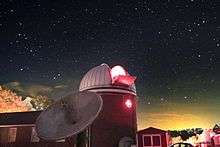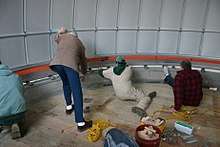Custer Observatory
Custer Observatory is an astronomical observatory owned and operated by Custer Institute. Located in Southold, New York (US), facing Peconic Bay and Shelter Island, Custer's location boasts some of the darkest skies on Long Island.[1]
 | |
| Location | Southold, New York |
|---|---|
| Coordinates | 41°03′07″N 72°26′04″W |
| Website | www |
 Location of Custer Observatory | |
Long Island's oldest public observatory, Custer Institute was founded in 1927 by Charles Wesley Elmer (co-founder of the Perkin-Elmer Optical Company), along with a group of fellow amateur-astronomers. The name was adopted to honor the hospitality of Mrs. Elmer, the Grand Niece of General George Armstrong Custer. In 1942, the Custer Institute was incorporated as a non-profit educational corporation in the State of New York.
In 1938, the group purchased the land the institute presently occupies and initial construction was completed in the spring of 1939. The 100-seat lecture hall was added in 1945. In 1947, through donations by Charles Elmer and Mr. Polk, the 3-story tower/library and observatory dome were built. In 1954, Charles Elmer died; that same year, the Institute added the shed, which houses three sliding roof observatories. Over the years, Custer has acquired a large collection of telescopes of all sizes and descriptions. Most recently, 10" Zerochromat refracting telescope and is the largest of its type in the United States. This is in the main observatory dome."
Our 10” refracting telescope was manufactured in England by Zerochromat Telescopes. Designed by award-winning optician Peter Wise, the telescope's unique dialyte lenses make it apochromatic, providing superior views of solar system and deep space objects. The folded light path construction uses mirrors to make the telescope a manageable size (still more than 6’ long), allowing the long f/12 focal length telescope to fit in our dome.
The telescope is attached to a computer-controlled Fornax 152 equatorial mount, permitting easy aiming and object tracking. The entire assembly can be raised/lowered on the Pier-Tech pier to accommodate most users’ heights, for comfortable viewing. Custer's Zerochromat telescope is the largest of its type in the United States."
Previously, the dome was home to a 25-inch (f/5) Obsession Newtonian reflector. In order to bring the eyepiece of this telescope to a level that does not require observers to climb a high ladder, the optics on this telescope were modified solely by Custer's own Justine Haupt, an engineer at Brookhaven National Lab. Justine is currently involved in working on the camera for the LSST.
Custer Library
The Custer Library contains a wealth of Astronomy and Science books dating from the 19th century to the present. It also houses the Institute's videotape collection and 35mm astronomical slide collection. It contains National Geographic, Sky & Telescope, Astronomy, and Scientific American magazines dating back numerous decades. Membership to the Custer Institute grants access to their library.
Custer Museum
The Custer Institute Museum (in place prior to the dome renovation but currently unavailable) contains the following in its collection:
- Henry Fitz, early Custer member and famous telescope mirror maker's Grinding Table. (Similar to the one on display at the Smithsonian in Washington, DC.)
- James Short's circa 1750 Gregorian telescope variation designed to read the separation of binary stars. One of only three known to exist.
- Various other 18th and 19th centuries vintage spectrometers and sextants, along with other astronomical devices.
- The Custer Rock Collection including geodes and numerous Fossilized Rocks.
- The Custer Meteorite Collection, which includes a Shergottite from Mars.
- Numerous astronomical, sunspot, and aurora pictures taken by past and present members.
- A broken 1750s roadside Mile Marker, recovered by Custer members that was originally ordered by Ben Franklin when he was the head of the Colonial Mail system.(Today, most of the other markers, still undamaged, mark the distance along the Main Road between Orient Point and the Old Riverhead Court House.)
- The Custer Civil War Bullet Collection.
- A piece of a tree that was originally planted at Bronx College by Albert Einstein (who often summered in Jamesport).
Telescopes
Custer has a large collection of telescopes of all sizes and description. Among them are:
- 25" Obsession Newtonian reflector (on loan from Suffolk Community College)
- 20" Obsession Newtonian reflector (on loan from Tom Pennino)
- 14" Celestron CGE-1400 Go-To Schmidt-Cassegrain (South Bay, Shed)
- 14" Meade LX200GPS-SMT
- 13" Newtonian dobsonian
- 12½" Newtonian reflector
- 12½" Newtonian reflector
- 12" Springfield designed by Russell Porter.
- 10½" Newtonian reflector ('Blue Odyssey Dob in the Dome')
- 10" Astro-binoculars, designed and built by one of the observatory members, Rico Verticchio, and on permanent loan to Custer.
- 9 ¼” Celestron CGE Go-To Schmidt-Cassegrain
- 8" Cave Astrola Cassegrain.
- 7" f/20 refractor
- 6" Ceravolo Maksutov Newtonian
- 6" f/10 Eichner refractor (in the Elmer room)
- 6" Alvan Clark refractor
- 5" Alvan Clark student model refractor
- 4½" James Short Gregorian Reflector (mid-18th century)
- 4" Unitron refractor, f/14.7
- 3.5" Bausch & Lomb refractor, f/13.7
- 80mm Jaegers refractor, f/15.4
- 2.4" brass refractor
- 7x21 Ross Camera, f/7 with a 3" lens, accepting 8x10 and 4x5 inch plate film.
- 8" SCT f/11 Canon TV Lens (mirror-lens design, converted for use as a telescope)
- 8" SCT f/5.6 mirror-lens (attaches to TV studio camera)
Public access
Generally the Custer Institute is open every Saturday evening, from dusk until midnight. Custer Observatory welcomes the general public to guided tours of the heavens—weather permitting.[2] The Custer Institute also allows its lecture hall to be used for lectures, in-service courses for educators, concerts, theatrical performances, and other events.
Images
 Messier object 42 by K. Massey, Custer Institute
Messier object 42 by K. Massey, Custer Institute logo
logo Eclipse / Occultation Photo by Phil Harrington, Custer Institute
Eclipse / Occultation Photo by Phil Harrington, Custer Institute Messier object 27 by K. Massey
Messier object 27 by K. Massey Custer Observatory - Night Sky, Dome and Radio Telescope
Custer Observatory - Night Sky, Dome and Radio Telescope Custer Observatory - Radio Telescope and Jupiter
Custer Observatory - Radio Telescope and Jupiter
See also
- List of observatories
References
- See the light pollution map on ClearSkyChart.com. Note that there is still quite a bit of light pollution compared to northern New York and other parts of the Northeast.
- Custer's current schedule of upcoming events Archived 2009-02-06 at the Wayback Machine(Consult the clear-sky-chart for current & predicted conditions.)
- "Custer Observatory Homepage". Custer Index | Web page designed by David van Popering. Retrieved August 19, 2009.
- "Montauk Observatory Project". Retrieved August 19, 2007.
External links
- Custer Observatory Website
- Custer Institute Clear Sky Clock Forecasts of observing conditions.
